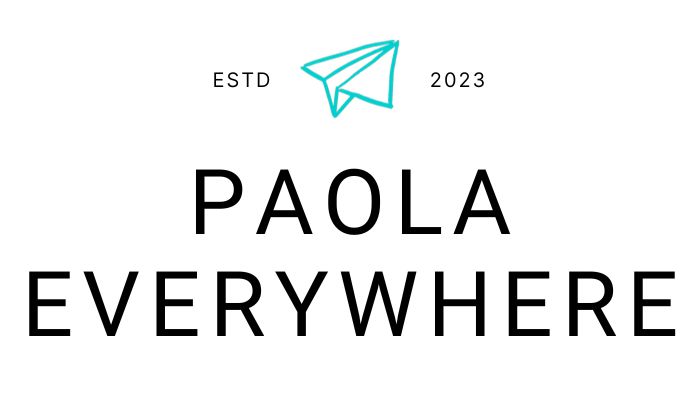Tihany is one of the most touristic villages on Lake Balaton. Yet, it remains a place worth exploring for its rich history and unique character. The ancient Benedictine Abbey dominates the peninsula, continuing to tell the story of centuries of Hungarian heritage. As you stroll through Tihany’s cobbled streets, you will find charming viewpoints, wooden sculptures and an abundance of lavender, the unmistakable symbol of the peninsula.
Table of Contents
Exploring Tihany: Historic Village on the Shores of Lake Balaton
Tihany sits on the northern shore of Lake Balaton and is a village where history, nature and traditions blend. Do not be put off by the many shops selling lavender-themed souvenirs. Once you step away from the most touristy streets, the atmosphere feels authentic and worth experiencing.
PLAN YOUR TRIP TO HUNGARY
For a road trip in Hungary, choose a Holafly eSIM: you will have unlimited internet to use Google Maps or any other GPS app, and you can share photos and videos in real time on WhatsApp and social media without any worries.
To travel with complete peace of mind, don’t forget to also take out Heymondo travel insurance, which protects you from unexpected events and ensures a worry-free holiday.
As you walk along the cobbled lanes, you’ll discover charming corners and wooden sculptures. These features connect you to the region’s winemaking tradition, which has been established here since the Middle Ages.
At the heart of the village stands the Benedictine Abbey. Founded in 1055, it dominates the landscape and remains Tihany’s main landmark. The adjoining museum tells the story of the monastery and its impact on the region. Temporary exhibits reveal unexpected curiosities such as the famous Anna Ball, an elegant event that feels worlds away from monastic life.
To end your visit, stop by the Lavender House. Here, you can discover essential oils, soaps, perfumes and even locally brewed lavender beer.
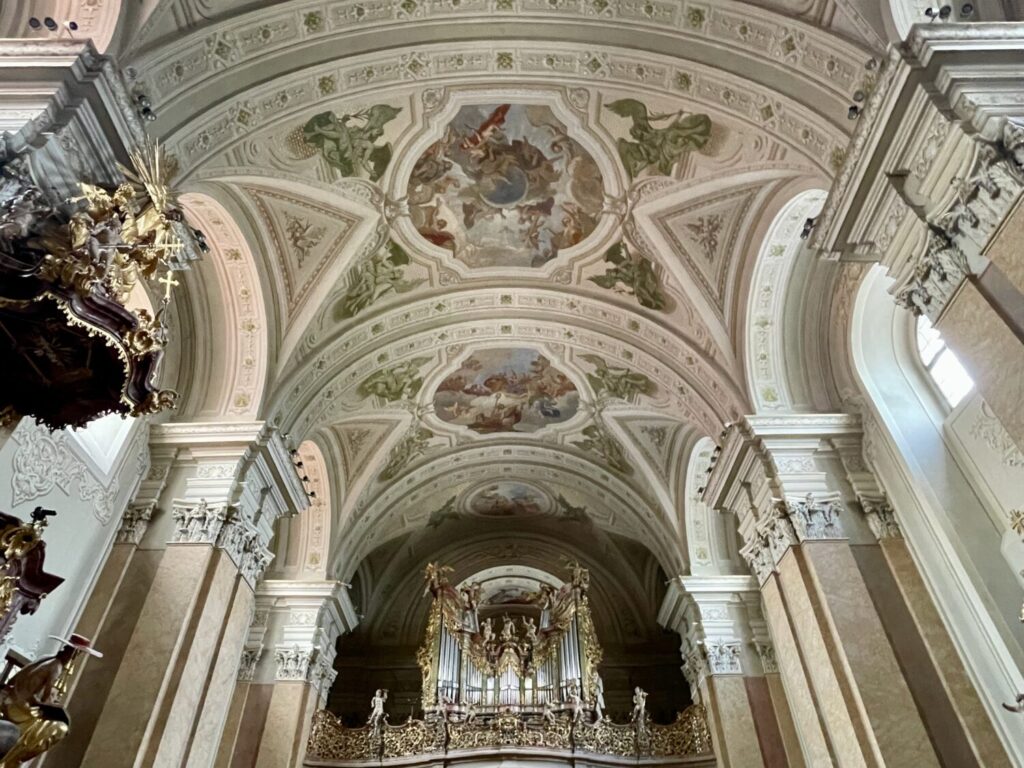
Benedictine Abbey of Tihany: Spiritual Heart with Panoramic Views
The Abbey of Tihany stands in a spectacular position on the promontory. Dominating the peninsula, it offers breathtaking views over Lake Balaton. You can spot it from a distance as a landmark when approaching Tihany.
Founded in 1055, the Abbey has withstood invasions, fires, and reconstructions, eventually assuming its current Baroque form in the eighteenth century. Today it is once again home to the Benedictine monks. Returned in 1993 after the communist era, they have now restored their spiritual role.
Inside, you will find a richly decorated Catholic church featuring frescoes and altars dedicated to Saint Benedict and figures associated with the Benedictine order. Among them, you can recognise Saint Scholastica and the Madonna of Mariazell.
During my visit, I wanted to see the cloister to get a sense of monastic life. Unfortunately, it remains closed to the public. What made up for it was the museum, which I found fascinating, with exhibitions and curiosities that enrich the visit.
You can buy tickets for the Abbey and the museum at the ticket office next to the main entrance. A single ticket grants access to the church, the crypt, and the museum, providing a comprehensive experience. I highly recommend this visit for understanding how the presence of the Abbey influenced Tihany’s life for centuries.
Tihanyi Apátság
Tihany, I. András tér 1, 8237 Hungary
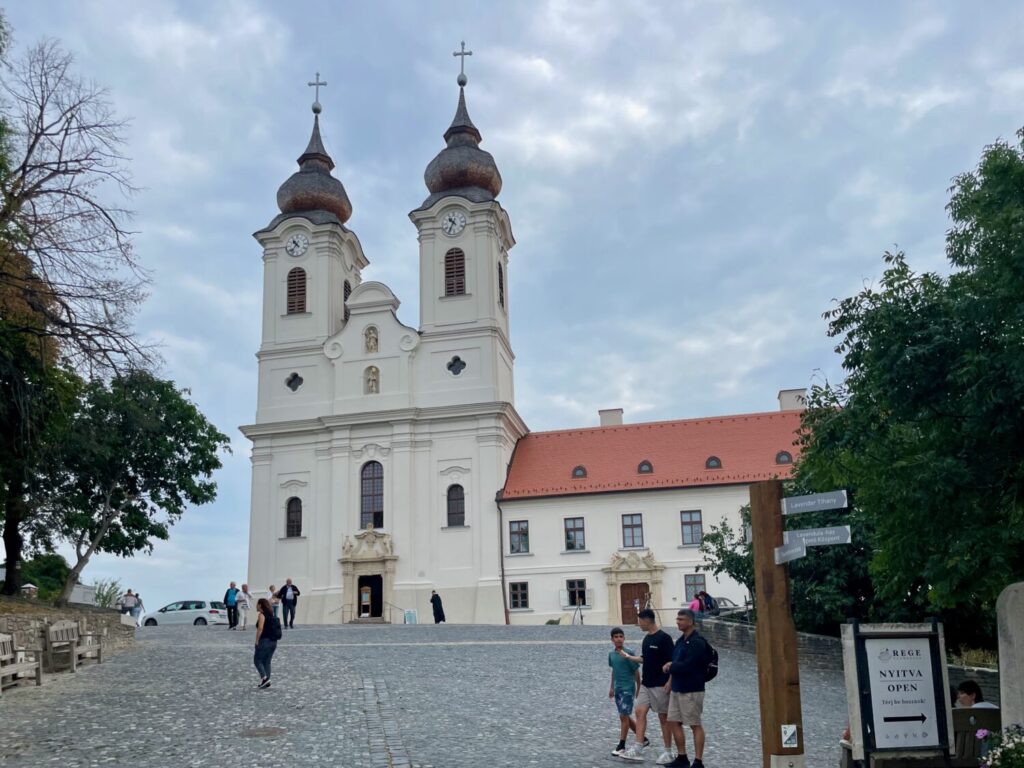
Tihany Abbey Museum: History, Curiosities and Local Traditions
For me, the Tihany Abbey Museum is one of the most interesting places to visit in the village. Permanent and temporary exhibits connect the story of the monastery with that of the peninsula and Lake Balaton.
Here I discovered details I would never have expected, from the passion of the first holidaymakers for Balaton souvenirs to the tradition of the Anna Ball. The highlight of the collection is the reproduction of the famous Tihany Abbey Charter of 1055. It’s the oldest surviving document containing words in the Hungarian language!
The museum is not just about displaying ancient objects. The exhibition is modern, enriched with multimedia installations that appeal to both adults and children. Beyond the history of the abbots who led the Abbey, the Tihany Abbey Museum also tells the story of the monks’ daily life and the non-monastic activities connected to the Balaton.
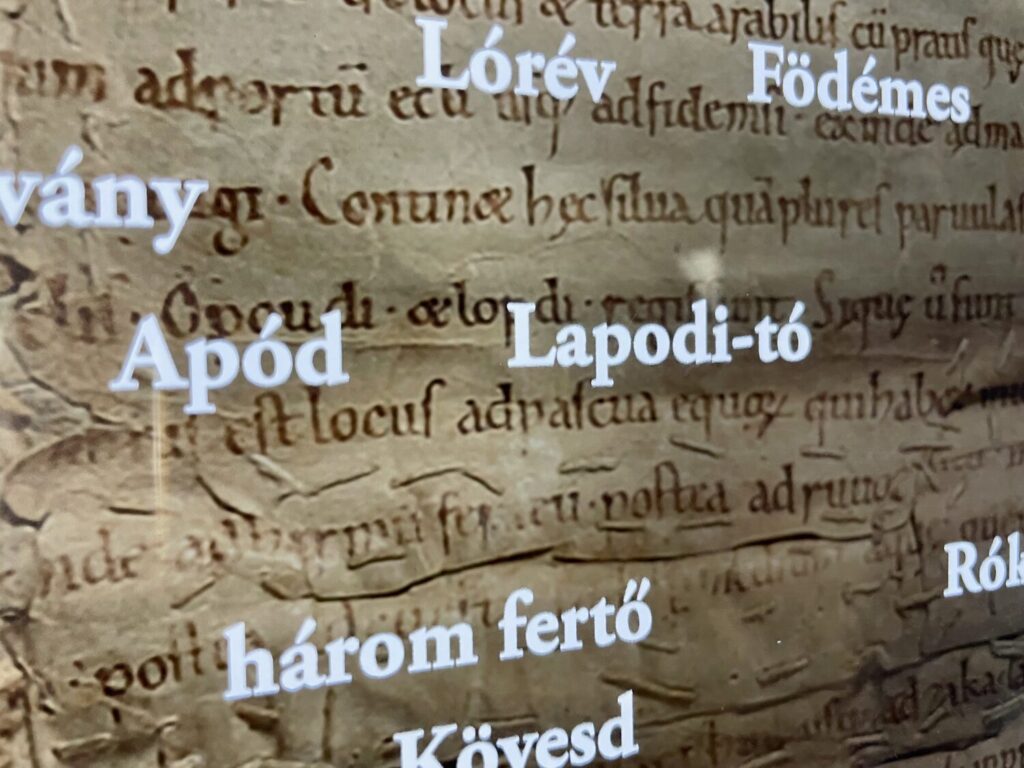
Daily Life of the Monks of Tihany: How They Lived, Worked and Ate
Visiting the Tihany Abbey Museum gave me a glimpse into how complex and well-organised monastic life really was, far more than I had imagined. The community was guided by the Latin motto ora et labora, meaning pray and work. The monastery operated as a self-sufficient system, meeting everyday needs without excess, with the goal of preserving knowledge and keeping traditions alive.
Each monk had a defined role. The abbot was both the spiritual and practical leader of the monastery. The prior maintained discipline and trained novices. Lay brothers were responsible for more practical tasks, ranging from caring for the sacristy to managing the pharmacy. Land management was also essential.
On the southern side of Lake Balaton, an agricultural steward oversaw the estates. To the north, the abbot himself was in charge. From the eighteenth century onwards, the Abbey also established parishes in neighbouring villages, extending its pastoral care to the local population.

The Tihany Abbey’s Cuisine
The Abbey’s cuisine reflected the same balance as monastic life itself. Meals were simple yet varied, typically consisting of three courses prepared with produce from the gardens, livestock, woodlands, and above all, Lake Balaton.
During the long fasting periods, monks abstained from eating meat. Still, the diet remained surprisingly rich, thanks to fish, vegetables, and even unusual ingredients such as snails, frogs, and waterfowl.
The monks of Tihany in past centuries likely ate far better than many of their contemporaries. Perhaps even better than many people do today!
I was fascinated to learn that on feast days, they enjoyed spirits and liqueurs. From the eighteenth century, they also began drinking coffee and tea regularly.
Imagining the monks ending their dinner with a strong drink made me smile. You would hardly expect such softness from those who had chosen a life of prayer and discipline!
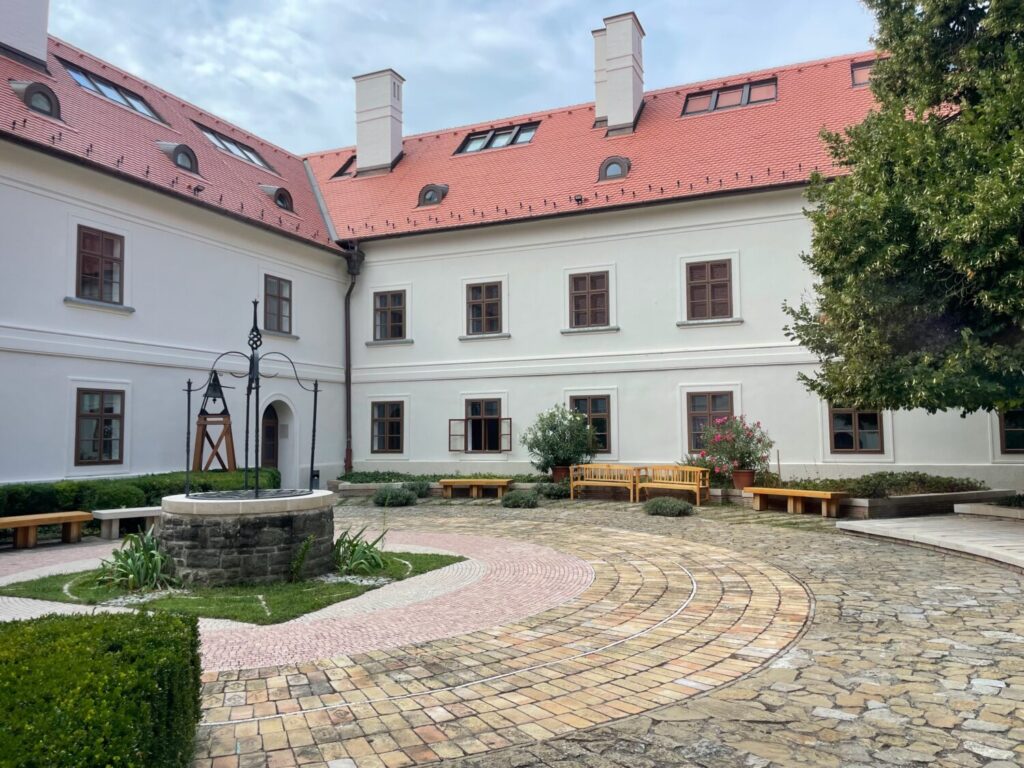
Temporary Exhibits About Traditions Beyond the Monastery
The Tihany Abbey Museum illustrates religious life and shows how the monastery shaped and connected with the secular activities around Lake Balaton. Spirituality and everyday life coexisted, with solemn liturgies on one side and popular festivities or spa leisure on the other. During my visit, I discovered that this region has been a tourist destination for centuries, thanks to the temporary exhibitions.
The thermal baths, with their medicinal waters, attracted visitors from all over Hungary, and holidaymakers would purchase souvenirs such as cups and mugs inscribed with the name Balatonfüred. Magnets did not exist yet, but travellers would not leave without at least a Herend porcelain coffee set decorated with romantic views of the lake.
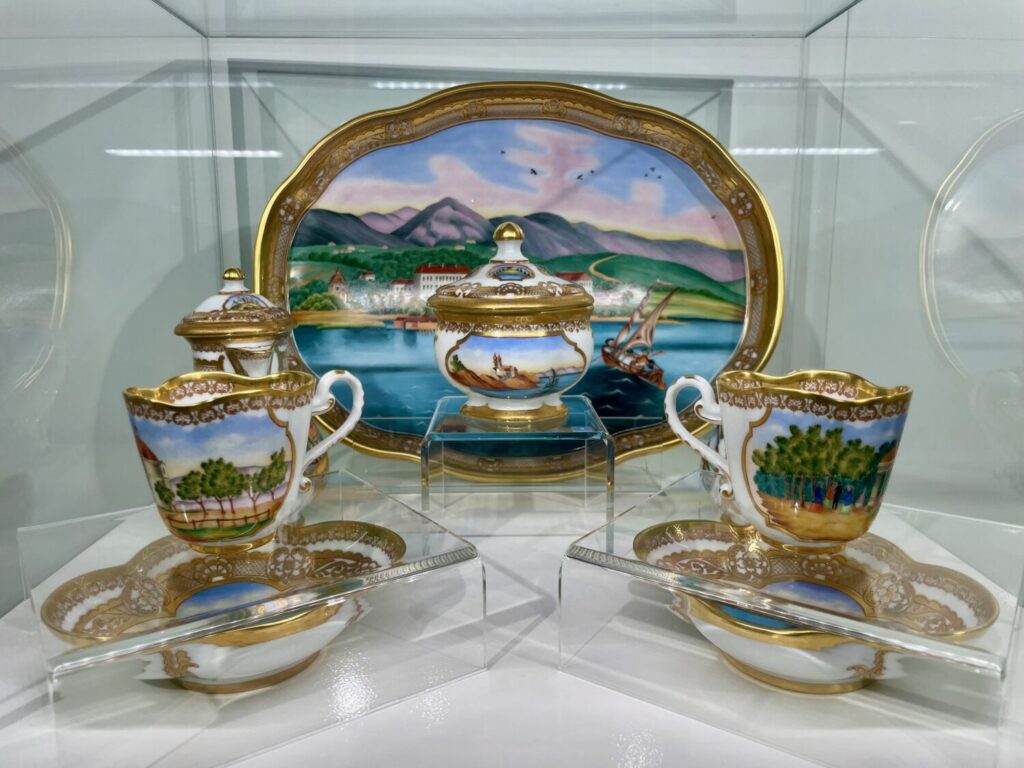
Among the most fascinating traditions is the Anna Ball of Balatonfüred. First held in the nineteenth century, it became one of the most glamorous social events on the lake. Elegant ladies in evening gowns, officers in uniform and summer visitors all took part in a ball that combined romance and society life.
After a break caused by the wars and the socialist period, the Anna Ball returned in the 1950s. It’s still celebrated today at the Anna Grand Hotel, remaining a symbol of Balaton.

Lavender House of Tihany: Discover Hungary’s Fragrant Treasure
Tihany is not only known for its Benedictine Abbey but also for its lavender. The peninsula is famous throughout Hungary for its lavender fields and the many products made from them. Everywhere you go, you will find dried bouquets, oils, soaps, and fragrant souvenirs, much like those found in Provence.
Lavender cultivation on Lake Balaton began in the 1920s. By the mid-1930s, the essential oil produced in Tihany was already considered of the highest quality. They were exported as far as Germany and the United States.
You can learn more about this tradition at the Lavender House Visitor Centre, connected to the Tihanyi Levendulaolaj Kft. distillery. Some areas allow you to watch part of the process of making natural cosmetics and other handmade products.
The Lavender House is open all year round. To reach it, my advice is to type ‘levendula haz’ in Hungarian into your sat nav. This will ensure you reach the correct destination without confusion. As often happens in Hungary, the translated directions on Google Maps aren’t, in fact, entirely reliable.
Levendula Ház Látogatóközpont
Tihany, Major u. 67, 8237 Hungary
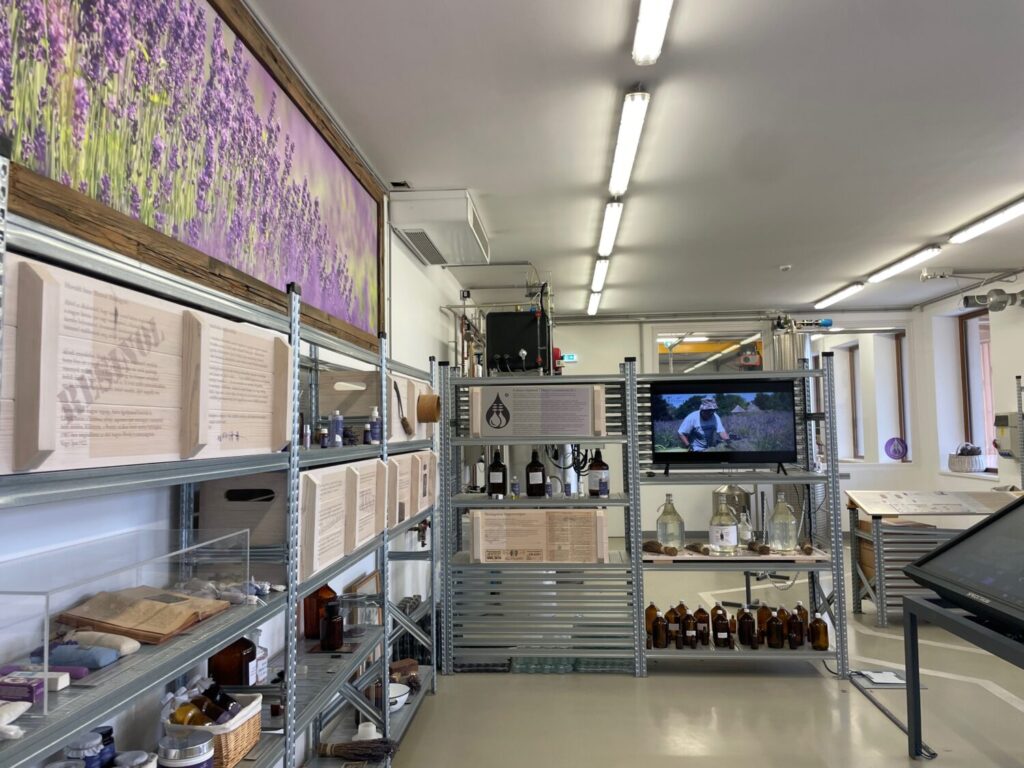
Things to Do on the Tihany Peninsula: Trails, Villages and Nature Walks
The Tihany Peninsula is a small natural paradise that stretches into Lake Balaton, offering unforgettable views. I found it the perfect place to combine a cultural visit to the Abbey and the village with an open-air walk.
The entire area is part of the Tihany National Park, a protected reserve that preserves the unique flora and fauna of Hungary. Walking along the trails, you can spot wildflowers, butterflies and water birds, and eventually reach the two inner lakes of the peninsula, formed inside ancient volcanic craters.
If you visit Tihany in June and July, you will also see the famous lavender fields that make this area so distinctive, rivalling those of Provence. During this period, hillsides turn purple and the air fills with fragrance.
For swimming in the lake, you can head to the equipped beaches along the Balaton shoreline, just a few minutes from the village. From Tihany’s marina, you can also take boat trips or guided tours to discover the lake from a different perspective.
From Tihany, you can admire Lake Balaton in all its splendour, with colours that shift constantly with the light and wind. In the Abbey Museum, there is even a display panel showing all the shades of the lake, like a natural Pantone chart.
If you decide to stay longer, you will soon realise that Tihany offers plenty of attractions.
The Lavender Fields of Tihany: A Purple Sea on Lake Balaton
The history of lavender in Hungary dates back to 1926, when chemist Gyula Bittera introduced French lavender to a rocky plot of land rented from the Abbey. Thanks to his work, the peninsula became one of the country’s leading centres for lavender production. Even today, experts still regard the essential oil distilled in Tihany as some of the highest quality produced in Hungary.
The lavender fields now cover more than 100 hectares of the Tihany Peninsula, and walking among them in bloom is an unforgettable experience. To see them at their best, plan your visit between June and July, during the peak of their blooming season. Lavender is also closely linked to the monastic and herbal traditions of Tihany. Monks still produce oils, soaps, scented pillows and even local liqueurs.
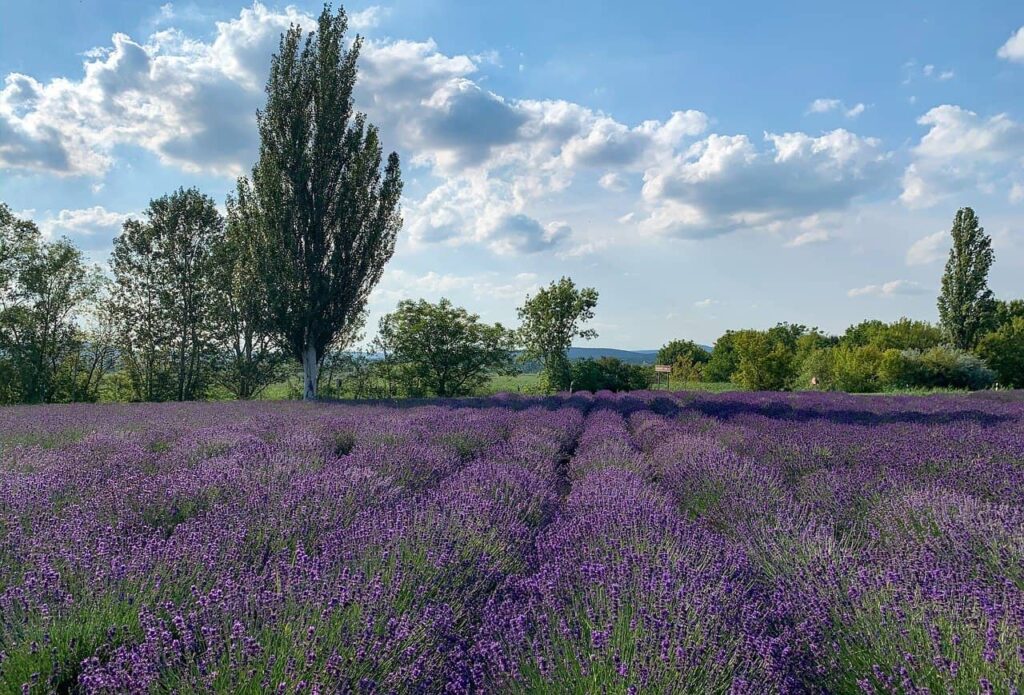
Spring Cave of Tihany: Traces of the Peninsula’s Volcanic Past
Among the natural curiosities of the peninsula is the Spring Cave of Tihany, a small cavity about 14 metres long and just one metre deep, formed by the ancient thermal waters of the area. Walking through the Tihany National Park, you might not imagine that millions of years ago, hot springs shaped this landscape by depositing calcium carbonate and silica. Over time, these minerals created striking cones and rock layers that still fascinate geologists and nature enthusiasts today.
In the Middle Ages, local soldiers used the cave as a shelter, but people forgot about it for centuries until researchers rediscovered it in 1951. Today it is regarded as a natural monument and a site of great scientific value, as it preserves evidence of the volcanic origins of the Tihany Peninsula and the unique bond between water, rock and the Balaton landscape.
Historical Ruins of Tihany: Fortresses, Churches and Ancient Settlements
Walking across the Tihany Peninsula is not only about admiring natural landscapes but also about discovering ruins that tell the millennial history of this land. In Roman times, Tihany was a real defensive island, connected to the mainland by a bridge.
Even in the foundation charter of the Abbey, dated 1055, it is referred to as an island. It was only in the eighteenth century, when the level of Lake Balaton dropped by approximately three metres, that the peninsula assumed its current shape.
The first fortification, known as Óvár (Old Castle), dates back to the late Bronze Age. It was built around 1000 BC on the northern side of the peninsula, and you can still see parts of its earthen walls today.
Scattered ruins across Tihany reveal how often invaders swept through the area. The monks built a fortress to defend the Abbey, guarded by around fifty soldiers, but this too was destroyed by the Turks. The same fate befell the village of Újlak, home to fishermen and boatmen, and the Romanesque church of Apáti.
Inner Lakes of Tihany: Exploring Lake Balaton’s Hidden Waters
One of the most surprising features of the Tihany Peninsula is the presence of two inner lakes, which make the landscape even more distinctive. These are not just simple bodies of water but basins created by the volcanic activity that shaped this area millions of years ago.
The Inner Lake (in Hungarian Belső-tó) lies 26 metres above the level of Lake Balaton. It reaches a depth of around 2–3 metres. Formed in a volcanic depression, it has always been used for fishing, and the abbot of the Abbey was even entitled to half of the revenues from the catch.
The Outer Lake (in Hungarian Külső-tó), on the other hand, was formed in the main crater of the now inactive volcano.
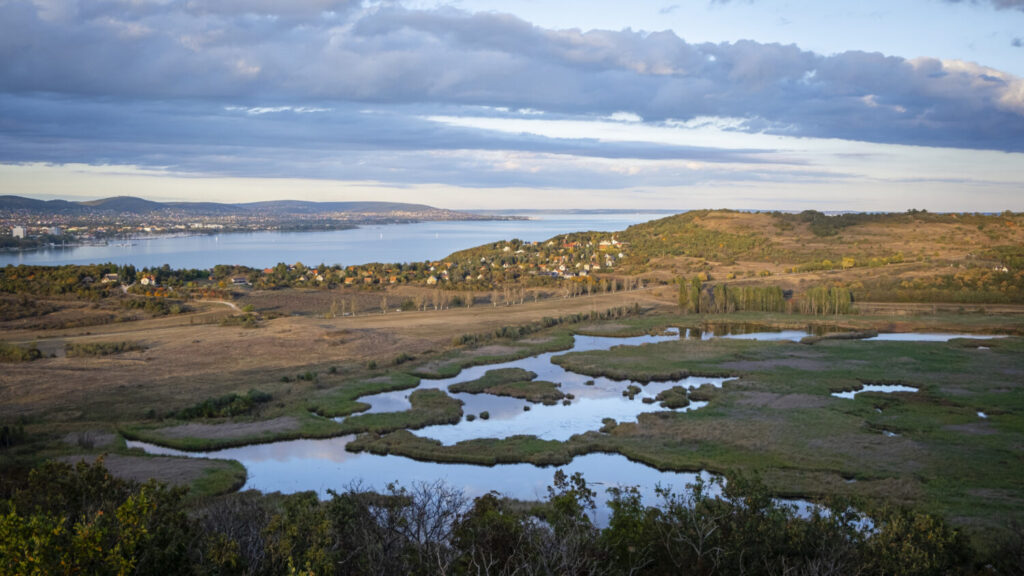
The Echo of Tihany: A Romantic Legend Across the Lake
Among the peninsula’s most fascinating curiosities is the famous echo of Tihany, a natural phenomenon that has been part of the Abbey’s heritage for centuries. Since the eighteenth century, the northern wall of the church would reflect words shouted from the hillside, returning an echo that was once repeated up to seven times.
Romantic legends grew around this phenomenon, such as the tale of the golden-haired fairy and the son of the king of Lake Balaton, a tragic love story that found its voice in the echo itself.
The echo of Tihany also inspired poets and writers. In 1803, Mihály Csokonai Vitéz dedicated a poem to it titled “A Tihanyi ekhóhoz” (To the Echo of Tihany).
Today, the sound is less clear due to the many buildings that have grown around and obstructed the propagation. Yet, it remains atmospheric, allowing one to call out and hear the hillside respond. This small ritual continues to connect visitors with centuries of traditions and local folklore.
Rock-Hewn Hermitages of Tihany: Silent Lives Carved in Stone
Another fascinating place to visit on the Tihany Peninsula is the Barátlakások, the ancient rock-hewn hermitages carved into the hillside. These chambers were created in the eleventh century by Orthodox monks from Kyiv who arrived with Anastasia, wife of King Andrew I.
In the Eastern tradition, the cells were known as petras, a term that even appears in the Abbey’s foundation charter, showing that monks were already living here before the arrival of the Benedictines.
The hermitages are on the eastern slope of Óvár Hill, within the Balaton National Park. You can reach them from the village of Tihany along a marked green trail. Carved into the basalt tuff of the hill, the hermitages still preserve several chambers that tell the story of the simple and silent life of the hermits.
A landslide in the fourteenth century led to the abandonment of the cells, and a further collapse in 1952 destroyed part of the complex. Despite this, three caves remain accessible today. They represent the only intact medieval hermitage settlement in Central Europe.
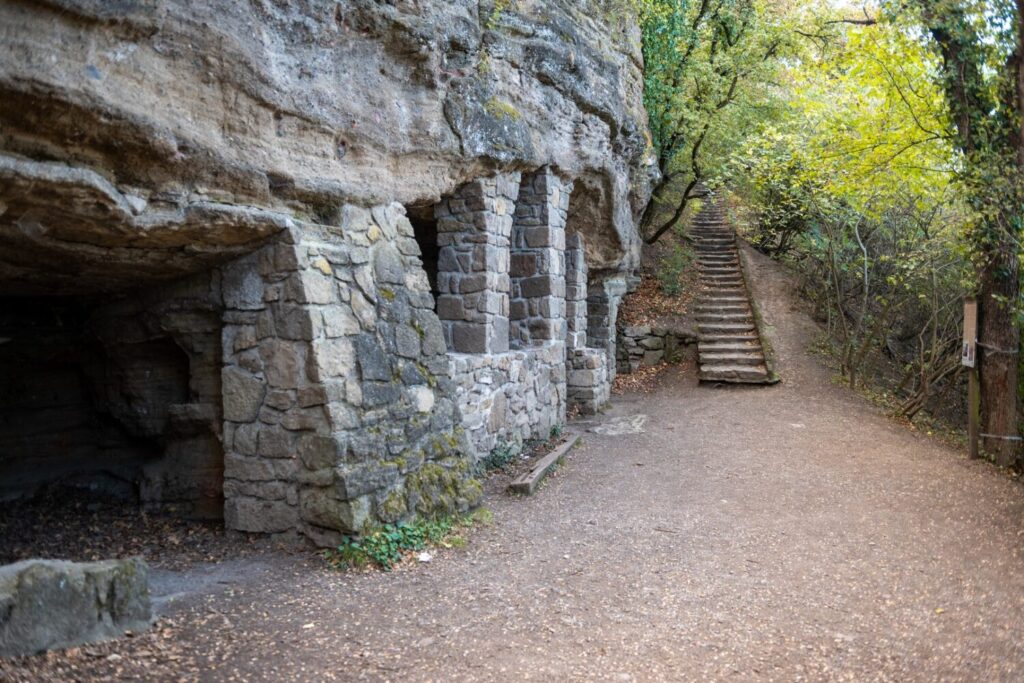
Practical Tips for Visiting Tihany on Lake Balaton
The best time to visit the Tihany Peninsula is between June and July, when the lavender fields are in full bloom. We visited Tihany in August and, unfortunately, the lavender had already been harvested, so we focused on the historic village and the Abbey instead.
In terms of transport, Tihany doesn’t have a train station. The nearest one is in Balatonfüred, from where several daily buses run to the village. Alternatively, you can book a guided day trip from Budapest or rent a car in Budapest.
Travelling by car is definitely the easiest way to explore Tihany and its surroundings. Perhaps combining it with a visit to the wonderful ethnographic village of Szentendre, as we did during our Hungary road trip.
The historic centre of Tihany has very few parking spaces, and all of them are paid parking. Private courtyards charge a slightly higher fee, around 400 forints per hour, while public roadside parking costs 300 forints per hour and can be paid easily through an app. There are several options available, but I recommend Mobilfizetés, which is simple to use and also works for parking at Tapolca’s Cave.
Whichever option you choose, I suggest arriving early in the morning so you can visit the Abbey at a relaxed pace and still have time to explore the surroundings, while avoiding the busiest hours.
Why Visit Tihany: A Must-See Village on Lake Balaton
Tihany is an unmissable stop on any trip to Lake Balaton, as it brings together history, faith, and nature. Strolling through the village streets, visiting the Benedictine Abbey, admiring the lavender fields and exploring the peninsula’s landscapes means experiencing a truly authentic part of Hungary. Let me know in the comments if you have already visited Tihany or if this article has inspired you to add it to your itinerary.
